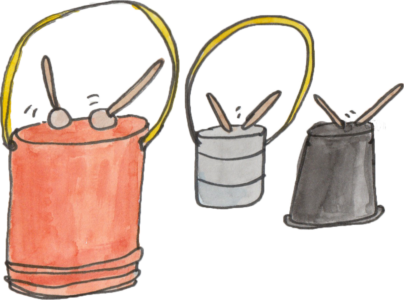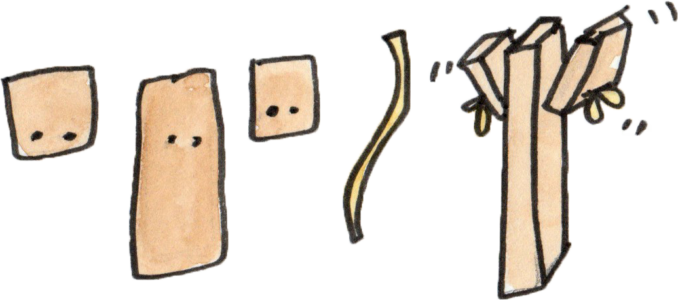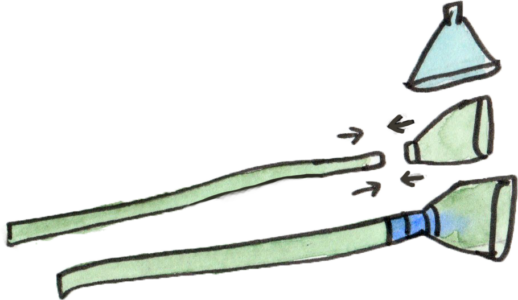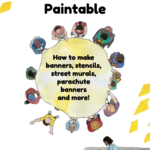SUPPLIES
- Buckets, cans, pots
- Sticks
- Strips of fabric
- Rubber tubes – such as old hoses
- Soda/pop cans, soda/pop bottles
- Rice, pebbles or beans
- Duct tape
- String
- Flat wood pieces
- Drill
- Utility knife or strong scissors
- Cardboard pieces
SHAKERS/MARACAS
- These are super easy to make and to play. Just cut two plastic soda bottles in half and put some pebbles, rice or beans inside. Stick the two halves together, tape them up and now shake.
- These can also be made out of soda/pop cans. Put pebbles, beans or rice into a dry can and tape a round piece of cardboard the size of the top of the can over the top to cover the hole. Shake.
- Make lots – they sound great together. Use different materials in the cans or bottles. They will make different sounds.
- You can also paint them or cover them with fun patterned duct tape! You don’t want to accidentally advertise a heartless multinational corporation.

DRUMS
Drums are perhaps the best (and simplest) of all DIY musical instruments. Drums in large numbers can have a BIG impact on the feel of an event (never underestimate the power of rhythm). Read more on organizing a drum corps below.
Small drums can be made using a tin can and hit it with sticks, a paintbrush, a large nail or a coin.
Medium drums can be made using large tin cans, buckets or flower pots. If you put a neck-strap on it’ you are free to play with both hands while walking. The easiest way to do this is to put two holes, one on either side of the drum (near the top) and make a strap using a thin piece of fabric. Tie knots around small sticks inside the drums to stop the fabric from slipping out. If you don’t want to make holes in good buckets, wrap rubber ties around the bucket and tie the strap to that. Hit with stick.
Big drums are the same as medium drums but bigger and louder! Use barrels, garbage bins, etc. For these you will want a different type of drumstick for deeper sounds. Tape a ball of fabric firmly around a sturdy stick (socks work well). It should look like a chicken drumstick. Next: Hit. Boom! Boom! Boom!

CLACKERS
Clackers are loud. All you need to make one is three pieces of flat wood (the longest piece ~5 inches/12 cm long), a drill and a piece of string.
Drill two holes through each piece of wood (you want these holes to lines up) then run the string through all three pieces and through both holes. Tie it loosely enough so the tops of the side pieces can flop around – that’s what makes them clack.

TUBE HORNS
Tube horns are ridiculous! Ridiculously fun!
Just get a short piece of hose-pipe or plastic tube (rigid or flexible) and tape the top of a soda bottle (or a cone of cardboard or a funnel) onto one end of it. Play it like a bugle. It should sound like a goose.

Shopping cart drum set
Put a bunch of drums, horns, whatever on a shopping cart and you can be a one person band or have a whole drum set that can move. Very useful for marches.
Now make an orchestra!
DRUM CORPS
 If you want more than DIY instruments you can also intentionally invite or create a drum corps! Here are few notes on drumming!
If you want more than DIY instruments you can also intentionally invite or create a drum corps! Here are few notes on drumming!
Drumming at demonstrations and events can be as simple as getting a couple of your DIY drummers to find a song with a nice beat and practice the different parts before the event. If you have more time and energy, you can organize a bigger group to drum, rehearse and plan your instruments, coordinate with organizers and get drummers to wear matching colors or costumes. Here are a few tips.
Why drums?
They can bring rhythm and festive energy to events. Marches and demonstrations become livelier, more aggressive, more confrontational, and more fun. Drums say “No Business As Usual!” and “Let’s Dance!” in a universal language. Drumming groups are easily organized compared with melodic marching bands. Sonic disruption can raise the stakes of demonstrations, legally and non-violently. Drums can win our enemies over to our side by showing them that this modern world has not dehumanized us. Drums are the quintessential tool for disrupting bureaucratic meetings when you can’t, or don’t want to, go inside. Chanting only gets so loud, and there are tighter restrictions on amplified sound than unamplified sound. No one asks why people bring signs, and bullhorns to demonstrations, but drums historically have also been a valuable tool in the struggle for social change, and they are resurging.
This section on Drum Corps is an excerpt from a longer manual put together by the Super Sonic Samba School. For more info and resources, rhythms, how to make drums and instruments and more go to: puppetista.org/drums/
Drum etiquette
Unfortunately, drums can also disrupt your own organization. If people aren’t listening to each other, the music will be bad, and people won’t be energized. Some crowds don’t like drums, period, even if they’re really hot. Also, drumming for demonstrations often means maximizing the volume in order to disrupt an event or reach a large crowd, but for the people right next to the drums, the noise can cause physical pain and permanent hearing damage.
Know when not to play
The social dynamics at demonstrations are different than open invitation drum circles. Drums may be used as part of a cultural ceremony or ritual — in which case it may not be appropriate for anyone to join. That would be different at an action where the sole goal is loud noise for disruption. Pay attention to the surroundings.
Playing along with chants
The message of drums is often ambiguous, so leave space for people who want to use words to clarify the issue. If you can organize it beforehand, find someone with a good sense of rhythm to lead chants that match your rhythm. Or have that person start a chant when you stop drumming. Make sure the chant leaders understand that they have to stay near the drums, and can’t run ahead or fall behind. Once you’re solidly locked-up with the chanters, try playing in the spaces where they are not chanting: “The people [ba-boom] united [ba-boom] will never be defeated [ba boom].”
Playing at other times
Drums are most powerful when they are played sparingly and with discipline. It’s annoying to hear drums during moments of silence, candlelight vigils, when people are speaking, or even when people are clapping (it’s like saying, my expressions are more important than yours, because my sound is louder). Drummers who aren’t constantly evaluating their surroundings and the effect their drumming has on people, risk being totally obnoxious. It’s a good habit to put your sticks away until you’re ready to play as a group. Some call this the “No noodling!” rule. Another way to put it is: “Don’t play unless everyone else is also playing!”.
While Marching
Keep the drum section together. Don’t let drummers spread out. Playing in unison requires being able to hear the other members of your group, which becomes more difficult the farther away you get.
Where to find drums?
Drums are everywhere: buckets, barrels, 5-gallon water bottles, pots and pans. Avoid bringing drum sticks that look like clubs to a demonstration.
Where to find drummers?
Drummers are everywhere too, and if you bring extra drums to a demonstration you can recruit people at the last minute to play along. Ideally, you can get a core group of people to practice before the demonstration, where they can learn the rhythms together, and learn the rules outlined above. Be sure to explain the rules to everyone taking an instrument who has not practiced with the group in advance.
